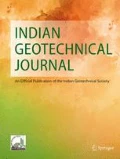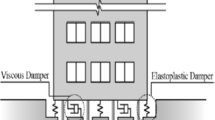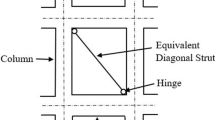Abstract
One of the major reasons for the popularity of reinforced soil structures is their ability to perform better under seismic loading conditions. This could be attributed to the conservatism associated with the design procedure that considers only the axial direction of the pullout force rather than an appropriate seismic design. The kinematics of failure, however, suggests that the direction of the pullout force is not axial, and it is inclined to the horizontal direction. This paper presents the pseudo-static stability analysis of a reinforced soil wall considering the obliquity of the pullout force, where the backfill soil is idealized as a two-parameter Pasternak model. The effect of various controlling parameters such as horizontal seismic coefficient, material properties of the backfill and the wall geometry on the pullout response is also studied under the seismic loading conditions. The results are compared with the conventional methods of analysis. The comparisons show that the present analysis removes the extra degree of conservatism prevailing in the conventional methods and thus gives a better estimation of the pullout capacity. A typical design of reinforced soil wall is also shown to demonstrate that the present analysis can be easily integrated with the existing methods.









Similar content being viewed by others
References
Tatsuoka F, Tateyama M, Uchimura T, Koseki J (1997) Geosynthetic-reinforced soil retaining walls as important permanent structures, the 1996-1997 Mercer Lecture. Geosynth Int 4(2):81–136
White DM, Holtz RD (1997) Performance of geosynthetic-reinforced slopes and walls during the Northridge, California Earthquake of January 17, 1994. Earth Reinforcement Balkema 2:965–972
Reddy GN, Choudhury D, Madhav MR, Reddy ES (2009) Pseudo-dynamic analysis of reinforced soil wall subjected to oblique displacement. Geosynth Int 16(2):61–70
Reddy GN, Madhav MR, Reddy ES (2008) Pseudo-static seismic analysis of reinforced soil wall—effect of oblique displacement. Geotext Geomembr 26(5):393–403
Basha BM, Basudhar PK (2005) Pseudo-static seismic stability analysis of geosynthetic reinforced soil retaining walls. Indian Geotech J 35(3):323–348
Gao Y, Yang S, Wu Y, Li D, Zhang F (2014) Evaluation of oblique pullout resistance of reinforcements in soil wall subjected to seismic loads. Geotext Geomembr 42(5):515–524
Ling HI, Leshchinsky D (1998) Effects of vertical acceleration on seismic design of geosynthetic-reinforced soil structures. Geotechnique 48(3):347–373
Ling HI, Leshchinsky D, Perry EB (1997) Seismic design and performance of geosynthetic reinforced soil structures. Geotechnique 47(5):933–952
Rowe RK, Ho SK (1997) Continuous panel reinforced soil walls on rigid foundation. J Geotech Geoenviron Eng ASCE 123(10):912–920
Nouri H, Fakher A, Jones C (2008) Evaluating the effects of the magnitude and amplification of pseudo-static acceleration on reinforced soil slopes and walls using the limit equilibrium horizontal slices method. Geotext Geomembr 26(3):263–278
Shahgholi M, Fakher A, Jones CJFP (2001) Horizontal slice method of analysis. Geotechnique 51(10):881–885
Sandri D (1997) A performance summary of reinforced soil structures in the greater Los Angeles area after the Northridge earthquake. Geotext Geomembr 15:235–253
Nimbalkar SS, Choudhury D, Mandal JN (2006) Seismic stability of reinforced soil wall by pseudo-dynamic method. Geosynth Int 13(3):111–119
Ismeik M, Guler E (1998) Effect of wall facing on the seismic stability of geosynthetic reinforced retaining walls. Geosynth Int 5(1–2):41–53
Sabhahit N, Madhav MR (2005) Seismic design of semi gravity reinforced earth wall. In: Proceedings of the Indian geotechnical conference, pp 361–364
Kumar PVSNP, Madhav MR (2009) Analysis of reinforced soil wall considering oblique pull: bilinear failure mechanism-linear subgrade response I. Lowl Technol Int 11(1):1–10
Patra S, Shahu JT (2012) Pasternak model for oblique pullout of inextensible reinforcement. J Geotech Geoenviron Eng ASCE 138(12):1503–1513
Patra S, Shahu JT (2015) Behaviour of extensible reinforcement resting on non-linear Pasternak subgrade subjected to oblique pull. Geotechnique 65(9):770–779
Patra S, Shahu JT (2015) Analysis of reinforced soil wall considering oblique pullout of reinforcement resting on two-parameter Pasternak subgrade. Geotechnical special publication (GSP 256), ASCE, Texas, USA: 1464–1472
Shahu JT, Hayashi S (2009) Analysis of extensible reinforcement subject to oblique pull. J Geotech Geoenviron Eng 135(5):623–634
Shahu JT (2007) Pullout response of inextensible sheet reinforcement subject to oblique end force. J Geotech Geoenviron Eng 133(11):1440–1448
Selvadurai APS (1979) Elastic analysis of soil-foundation interaction. In: Developments in geotechnical engineering, vol 17. Elsevier, Amsterdam
Kramer SL (1996) Geotechnical earthquake engineering. Prentice Hall, Upper Saddle River
Koerner RM (2005) Designing with geosynthetics, 3rd edn. Prentice Hall, Upper Saddle River
Christopher BR, Gill SA, Giroud J-P, Juan I, Mitchell JK, Schlosser F, Dunnicliff J (1989) Reinforced soil structures. vol I, Design and construction guidelines, FHWA, Federal Highway Administration Report FHWA-RD-89-043, 287p
Bathurst RJ, Cai Z (1995) Pseudo-static seismic analysis of geosynthetic reinforced segmental retaining walls. Geosynth Int 2(5):787–830
Seed HB, Whitman RV (1970) Design of earth retaining structures for dynamic loads. In: ASCE specialty conference: lateral stresses in the ground and design of earth retaining structures, Ithaca, NY, pp 103–147
Wolfe WE, Lee KL, Rea D, Yourman AM (1978) The effect of vertical motion on the seismic stability of reinforced earth walls. In: Proceedings of ASCE symposium on earth reinforcement, Pittsburgh, PA, USA, April 1978, pp 856–879
BSI (2010) BS 8006-1: Code of practice for strengthened/reinforced soils and other fills. British Standards Institution, London
Ho SK, Rowe RK (1996) Effect of wall geometry on the behaviour of reinforced soil walls. Geotext Geomembr 14:521–541
Ling HI, Mohri Y, Leshchinsky D, Christopher B, Matsushima K, Liu H (2005) Large-scale shaking table tests on modular-block reinforced soil retaining walls. J Geotech Geoenviron Eng 131(4):465–476
Allen TM, Bathurst RJ (2013) Design and Performance of 6.3-m-High, Block-Faced Geogrid Wall Designed Using K-Stiffness Method. J Geotech Geoenviron Eng 140(2):04013016
Liu H (2016) Required reinforcement stiffness for vertical geosynthetic-reinforced-soil walls at strength limit state. Géotechnique 66(5):424–434
Yu Y, Bathurst RJ, Allen TM (2016) Numerical modeling of the SR-18 geogrid reinforced modular block retaining walls. J Geotech Geoenviron Eng 142(5):04016003-1-13
Tafreshi SNM, Nouri T (2008) A seismic stability of reinforced retaining wall. In: The 14th world conference on earthquake engineering, October 12–17, 2008, Beijing, China
Acknowledgements
This work was supported in part by funding from the Science and Engineering Research Board (Grant No. ECR/2016/000137).
Author information
Authors and Affiliations
Corresponding author
Additional information
Publisher's Note
Springer Nature remains neutral with regard to jurisdictional claims in published maps and institutional affiliations.
Rights and permissions
About this article
Cite this article
Patra, S., Shahu, J.T. Pseudo-static Analysis of Reinforced Soil Wall Based on Pasternak Model. Indian Geotech J 50, 252–260 (2020). https://doi.org/10.1007/s40098-019-00400-7
Received:
Accepted:
Published:
Issue Date:
DOI: https://doi.org/10.1007/s40098-019-00400-7




